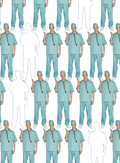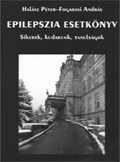The eLitMed.hu medical portal uses computer cookies for convenient operation. Detailed information can be found in the Cookie-policy.
Clinical Neuroscience - 2010;63(07-08)
Content
[Neurological and psychiatrical prospects of apathy]
[During his long practice as head physician of a neurological and psychiatrical department with over 100 beds performed the examination and department of more than a hundred thousand patients. Based on the acquired experience and the data of the most recent literature he treats every aspect of the apathy syndrome. He emphasizes the multidisciplinary approach during both establishing the causes and the examination and treatment of patients. In order to clarify the diagnosis consultations with other disciplines must be used as well as the the knowledge provided by the now essential CT, MRI, PET, SPECT. The author discusses the international therapeutical possibilities and practice after the recently alredy possible exact diagnosis.]
[Prophylactic migraine treatment with topiramate]
[Migraine is a very common disorder characterized by the combination of typical headache with associated autonomic symptoms and ranked by the WHO as number 19 among all diseases worldwide causing disability. Considerable progresses have been made in recent years to understand the pathophysiology of migraine, which has led to improved treatment options for the acute migraine attack as well as migraine prophylaxis. When headaches are frequent or particularly severe, prophylactic therapy should be considered, however preventive treatment is often insufficient to decrease migraine frequency substantially or is not well tolerated. The present paper summaries the possible drug treatment options which have the A level of evidence for effective preventive therapy of migraine. Summarises the evidences for the prophylactic migraine treatment, specially the role of the newly approved topiramate in the prophylaxis.]
[Immune responses and neuroimmune modulation in the pathogenesis of acute ischemic stroke and poststroke infections]
[Acute-onset cerebrovascular diseases are connected to a number of immunological changes. Here, we summarize immune responses participating in the evolution of atherosclerotic plaques and poststroke local immune responses in the injured CNS as well as in the systemic circulation. Ischemic injury of the CNS alters the balanced neuroimmune modulation resulting in CIDS, the central nervous system injury-induced immune deficiency syndrome. Due to the immunodepression and reduced pro-inflammatory immune responses, the susceptibility for infection is increased; indeed, poststroke infection plays a major role in stroke-related mortality. On the other hand, CIDS may protect against damaging autoimmune responses elicited by exposed CNS antigens. Investigation of immune responses related to ischemic stroke may result in novel therapies indicated by an increasing number of experimental and clinical trials altering poststroke immune responses and preventing infections.]
[The effect of Stalevo-dosing on quality of life of parkinsonian patients with wearing-off]
[In Stalevo tablets, used in the therapy of patients with Parkinson’s disease, levodopa is combined with decarboxylase inhibitors and COMT inhibitors to provide a more steady plasma concentration of levodopa. Previously several study has shown, that the better pharmacokinetic profile decreases the fluctuation of motor and non-motor symptoms. Better control of symptoms improves quality of life. Ideal blood levels of levodopa however can only be achieved by multiple daily dosing. This may be uncomfortable, may decrease compliance, thereby influence quality of life. To evaluate this a observational follow-up study was undertaken in Hungary in 2007, among patients, who were given Stalevo - independently of this study - because of signs of decrease in the duration of drug effect (wearing off). Patients got Stalevo in three, four or five daily divided dosages, the results were assesed after three months. The study included 223 patients (ITT population), of whom 208 (PP population) responded regarding quality of life on both visits. Statistical analysis of the results showed that treatment significantly decreased symptoms of wearing off (wearing off card with 19 items) and improved quality of life (EQ-5D and VAS quality of life scale) regardless of the frequency of dosing.]
[New surgical technique for atlanto-axial instability: C1-2 dorsal fixation with the screw-rod system]
[Objective - It is still challenging to perform the operation for the instability of the C1-C2 junction because of the limited cases, unique anatomical landmarks, the potential or real injury of the neurological elements, the serious clinical state and the special technical and human background is demanding. With the aim of minimalize the risk the following method provide sufficient stability, successful and simple. Method - The authors used the dorsally implanted screwrod systems for operating 34 patient with C1-2 instability resulting clinically signs and symptoms. Depending the anatomical landmarks and the technical possibilities, the screw insertion method and the reinforced wire cable use was selected. Meaning the indication of the surgical treatment, the neurological signs, compromise of the spinal canal and pain resisting the conservative treatment was presented. Result - The C1-2 dorsally fixation was performed to 34 patients. Both sided lateral mass screw was inserted in 30 cases (88.3%). Because of the anatomical landmarks in four cases (11.7%) the one sided screwing was made by the Magerl technique. Pure bone quality detecting intraoperatively demand reinforcement with titanium cables for three cases (8.8%). Pain resulted of instability was recovered. The clinical and neurorariological follow-up present perfect result for 26 patients (76%), good result for six patients, there was respectable result for two patients. Most of the patients, 31 cases (91%) were satisfied, and three patients (9%) consider their condition acceptable. Conclusion - Performing the represened techique, the risk and the time of the operation was decreased reducing the rate of the complications. The method providing full stability resulted immediate axial painless, no outer support and early mobilization is possibile. Summarizing this technique is safe, reliable and cost effective.]
[The future in danger: a survey of the changes in the number of neurologists and a prognosis for 2010 in Hungary]
[Lack of neurologists has become an obvious problem recently in Hungary, not only in small hospitals, but in major health care centers and also in university hospitals. With the current survey we set forth to estimate the number of board certified neurologists, and to evaluate the foreseeable changes in the next decade. In the beginning of 2010 there were 1310 physicians in Hungary with an official license to practice neurology. During 2009 neurological performance at least once during the year was claimed to the National Health Insurance Fund by 948 board certified neurologists. The number of those neurologists who are routinely involved in neurological patient care was estimated to be around 750. The lack of the young generation is characteristic for the age distribution of neurologists. In nine out of the 19 counties of Hungary the number of neurologists below the age of 35 is one or nil. In the ten-year period of 2000-2009 the annual mean number of new board certifications in neurology was 22. This number is much lower than that needed to replace those who get employed abroad and who leave the system for other reasons. The number of neurologists in the age range of 40-60 years will drop to 2/3 of the current number by 2020 even if emigration of neurologists will completely halt. If emigration will continue at the current rate and the number of those in neurological training will not increase considerably, then by 2020 only about 300 neurologists will have to cover neurological services throughout Hungary. As this number is insufficient for the task, and the tendency is clearly foreseeable, the health care government should urgently react to this situation to ensure an acceptable level of neurological services in the near future for the population of Hungary.]
[Clinical, radiological and genetic aspects of leukodystrophies]
[The authors summarize the pathomechanism of the myelination process, the clinical, radiological and the genetical aspects of the leukodystrophies, as in 18q deletion syndrome, adrenoleukodysrtophy, metachromatic leukodystrophy, Pelizaeus-Merzbacher leukodystrophy, Alexander disease and olivo-ponto-cerebellar atrophy (OPCA).]
[Book of epileptic cases. Successes, failures, lessons]
[Book of epileptic cases. Successes, failures, lessons 2010;63(07-08)]
1.
Clinical Neuroscience
[Headache registry in Szeged: Experiences regarding to migraine patients]2.
Clinical Neuroscience
[The new target population of stroke awareness campaign: Kindergarten students ]3.
Clinical Neuroscience
Is there any difference in mortality rates of atrial fibrillation detected before or after ischemic stroke?4.
Clinical Neuroscience
Factors influencing the level of stigma in Parkinson’s disease in western Turkey5.
Clinical Neuroscience
[The effects of demographic and clinical factors on the severity of poststroke aphasia]1.
2.
Clinical Oncology
[Pancreatic cancer: ESMO Clinical Practice Guideline for diagnosis, treatment and follow-up]3.
Clinical Oncology
[Pharmacovigilance landscape – Lessons from the past and opportunities for future]4.
5.

















